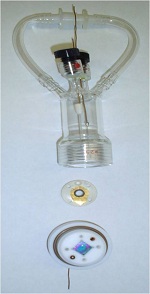Research Information
Mechanistic Organic
 Many modern organic syntheses still require harsh conditions and toxic reagents; one goal of organic electrochemistry, congruent with green chemistry, is to eliminate the necessity of these undesirable features. In conjunction with developing mild and efficient methods for electrosynthesis of useful organic products, we also desire to elucidate mechanistic pathways and reaction kinetics, which are obtained by adding a dash of electroanalytical methods. Our focus is on halogenated organic compounds that, upon electrochemical reduction, can undergo intramolecular cyclization, ring-expansion, and other useful organic reactions. Present research extends into exploration of nickel and cobalt salen as solution-phase and polymer-bound catalysts, employing ionic liquids as solvent-electrolyte, and the use of silver as a catalytic cathode material.
Many modern organic syntheses still require harsh conditions and toxic reagents; one goal of organic electrochemistry, congruent with green chemistry, is to eliminate the necessity of these undesirable features. In conjunction with developing mild and efficient methods for electrosynthesis of useful organic products, we also desire to elucidate mechanistic pathways and reaction kinetics, which are obtained by adding a dash of electroanalytical methods. Our focus is on halogenated organic compounds that, upon electrochemical reduction, can undergo intramolecular cyclization, ring-expansion, and other useful organic reactions. Present research extends into exploration of nickel and cobalt salen as solution-phase and polymer-bound catalysts, employing ionic liquids as solvent-electrolyte, and the use of silver as a catalytic cathode material.
Environmental
 We like to say that electrochemistry is saving the world - one electron at a time! As time passes, scientists have become aware that chemicals promised to advance life have started to harm the environment; probably best known are chlorofluorocarbons (CFCs), which are detrimental to the ozone layer. Due to this heightened awareness, it is necessary to terminate the use of CFCs and, while some are set aside in storage stockpiles, incineration offers an inefficient way to dispose of them; therefore, we desire to develop electrochemical methods to remediate CFCs efficiently. Additionally, the Peters group is interested in the determination and remediation of pollutants in aqueous environments, e.g., trihalomethanes (THMs) and haloacetic acids (HAAs) which are contaminants in drinking water, by electrochemical means.
We like to say that electrochemistry is saving the world - one electron at a time! As time passes, scientists have become aware that chemicals promised to advance life have started to harm the environment; probably best known are chlorofluorocarbons (CFCs), which are detrimental to the ozone layer. Due to this heightened awareness, it is necessary to terminate the use of CFCs and, while some are set aside in storage stockpiles, incineration offers an inefficient way to dispose of them; therefore, we desire to develop electrochemical methods to remediate CFCs efficiently. Additionally, the Peters group is interested in the determination and remediation of pollutants in aqueous environments, e.g., trihalomethanes (THMs) and haloacetic acids (HAAs) which are contaminants in drinking water, by electrochemical means.
Biological
 We aim to examine biologically relevant compounds by electrochemical means to gain knowledge of their behavior. For example, by examination of the electrochemical behavior of piperazinyl amidrazones and the effect of various substituents, we hope to illuminate if there is a correlation between the electrochemistry and anticancer activity. We also hope to study the electrooxidation of histamine which is a biogenic amine and is present in many food products as well as in the body. Another project extends into the measurement of the redox potentials of various metalloproteins.
We aim to examine biologically relevant compounds by electrochemical means to gain knowledge of their behavior. For example, by examination of the electrochemical behavior of piperazinyl amidrazones and the effect of various substituents, we hope to illuminate if there is a correlation between the electrochemistry and anticancer activity. We also hope to study the electrooxidation of histamine which is a biogenic amine and is present in many food products as well as in the body. Another project extends into the measurement of the redox potentials of various metalloproteins.

